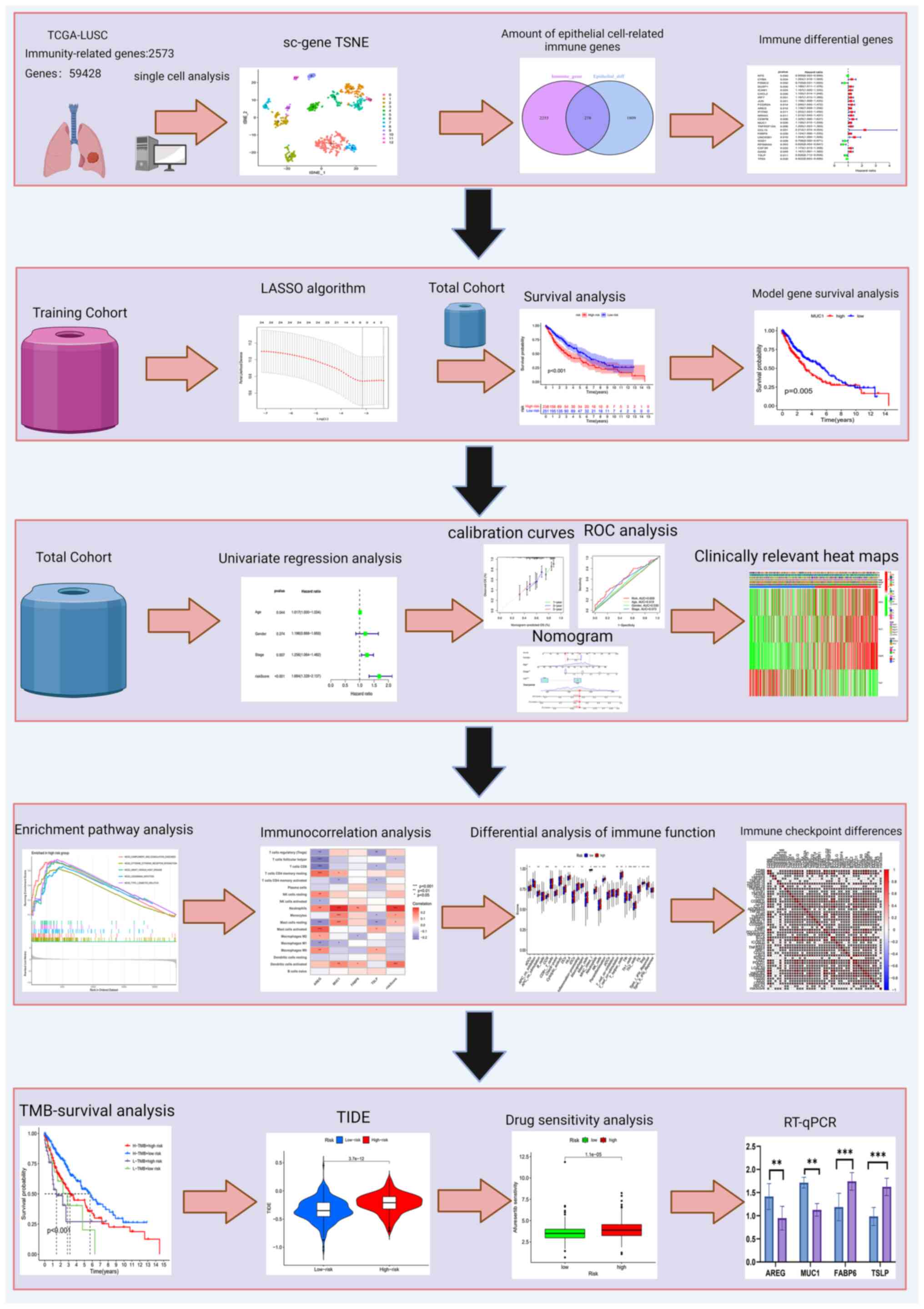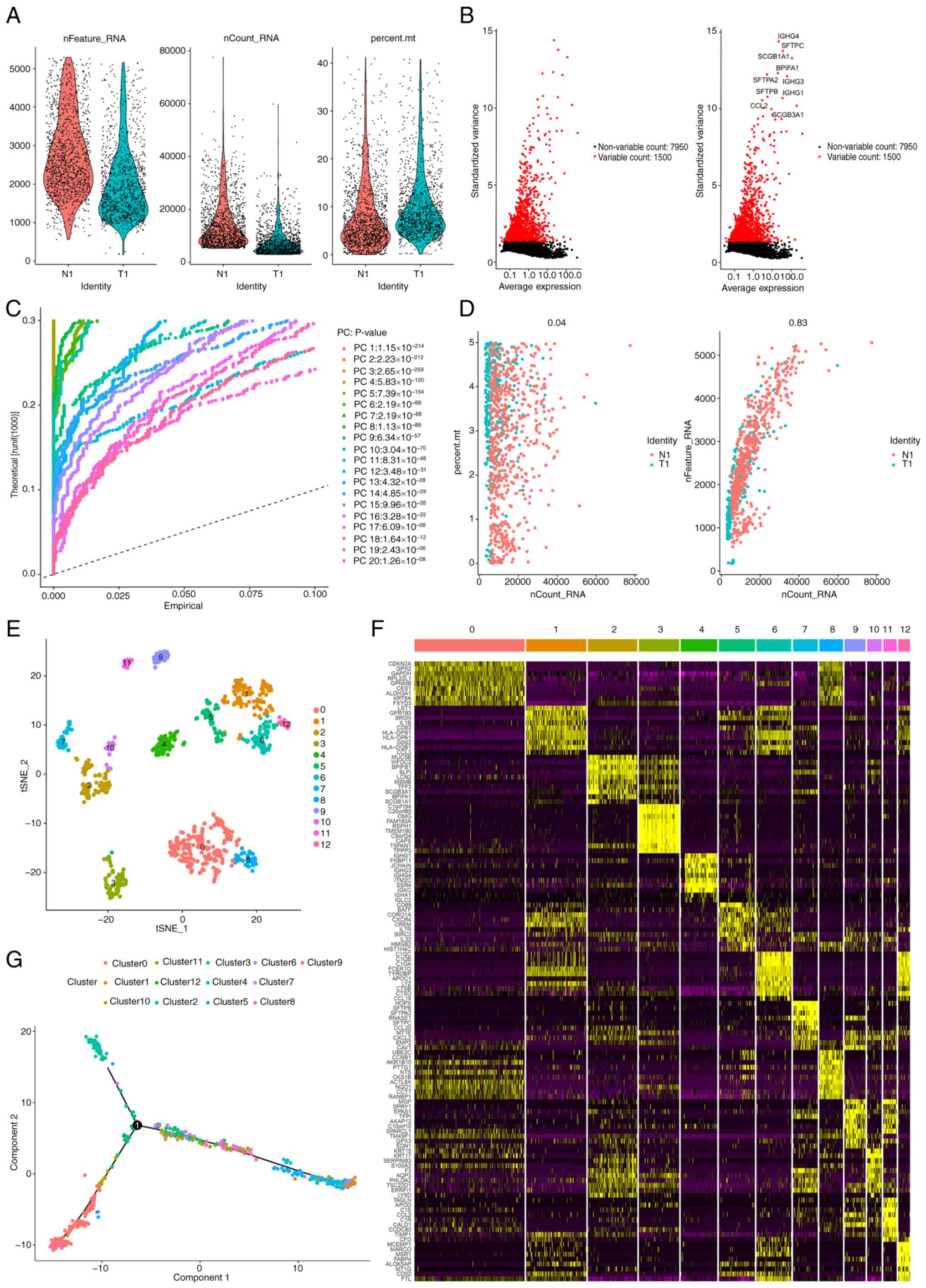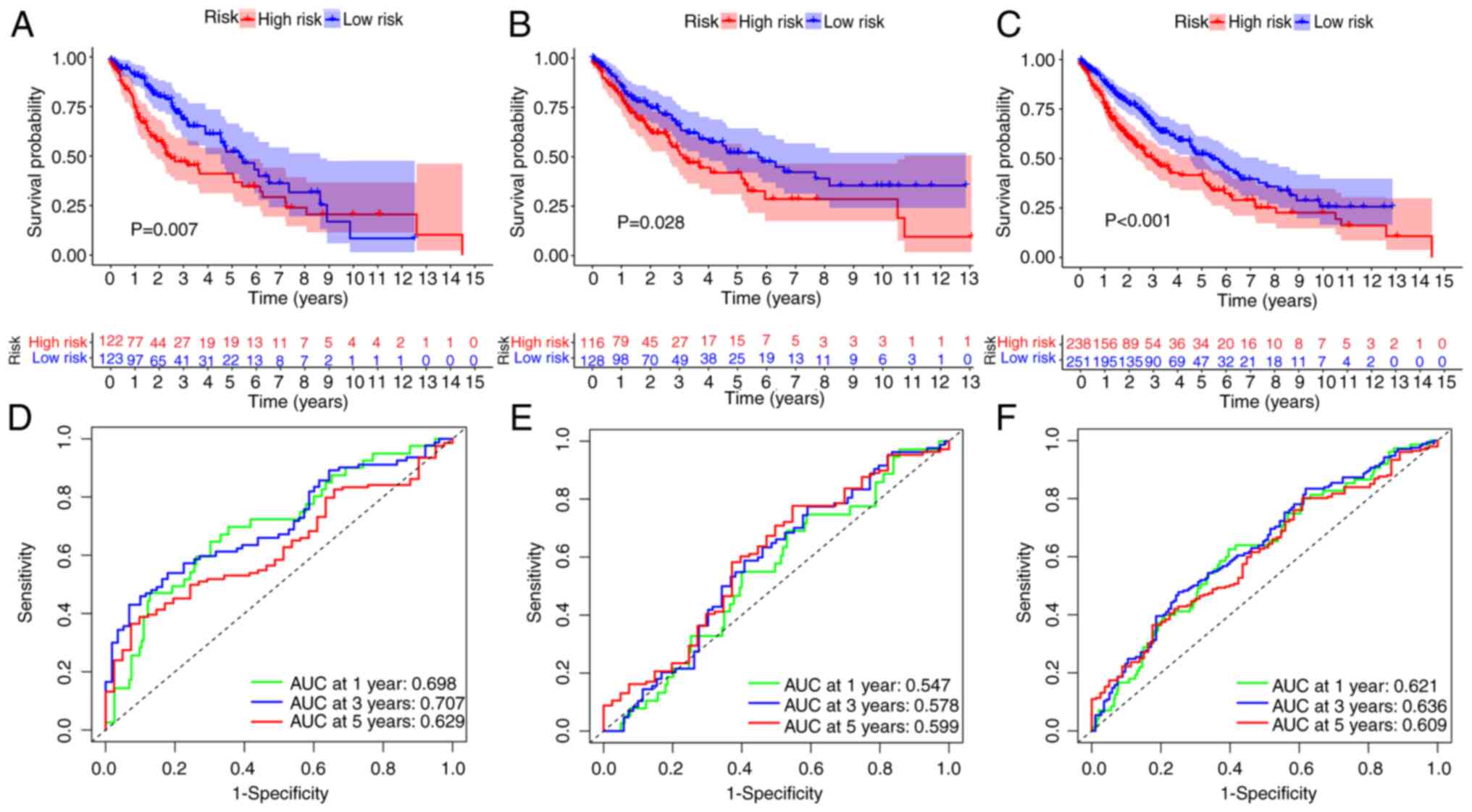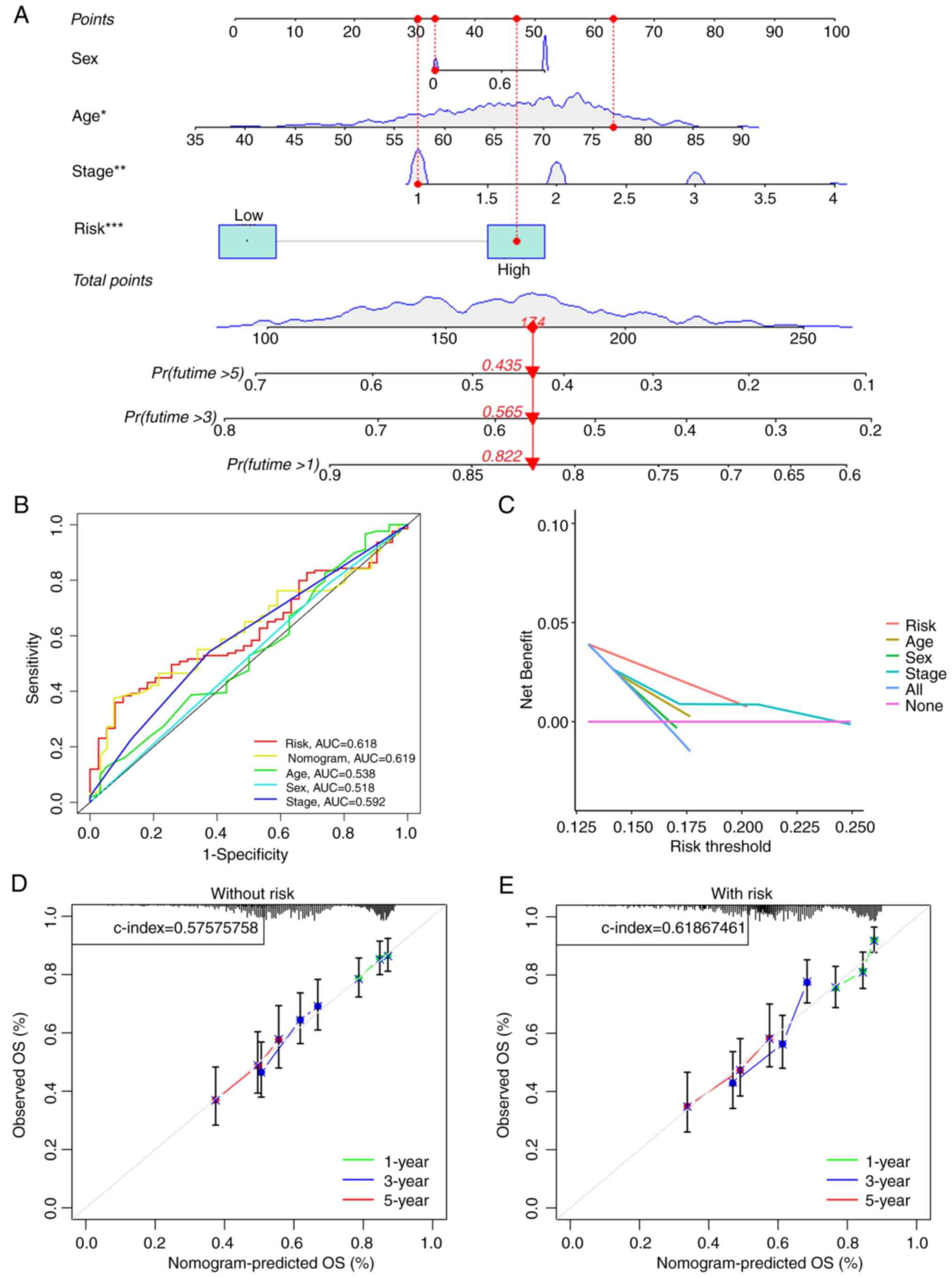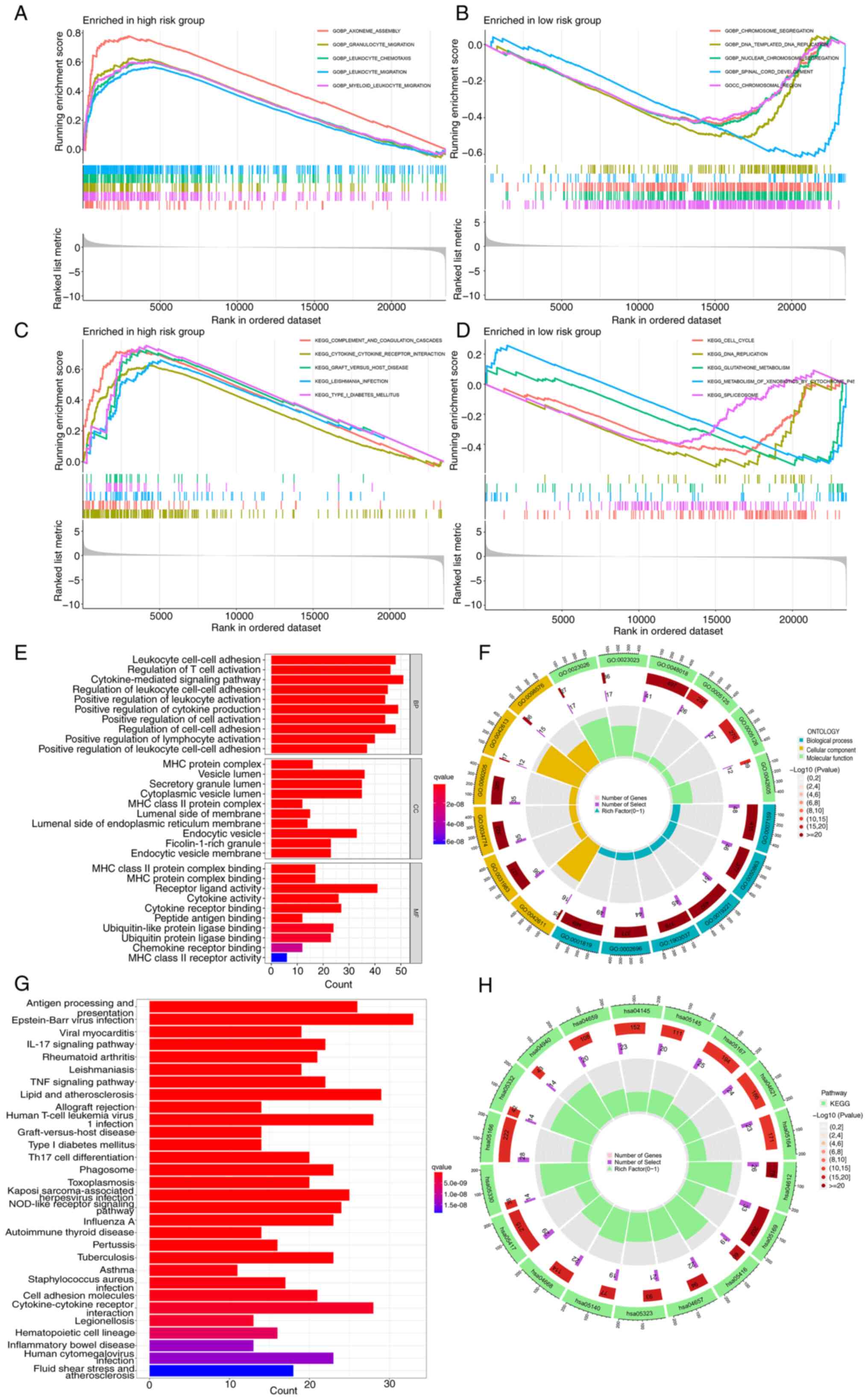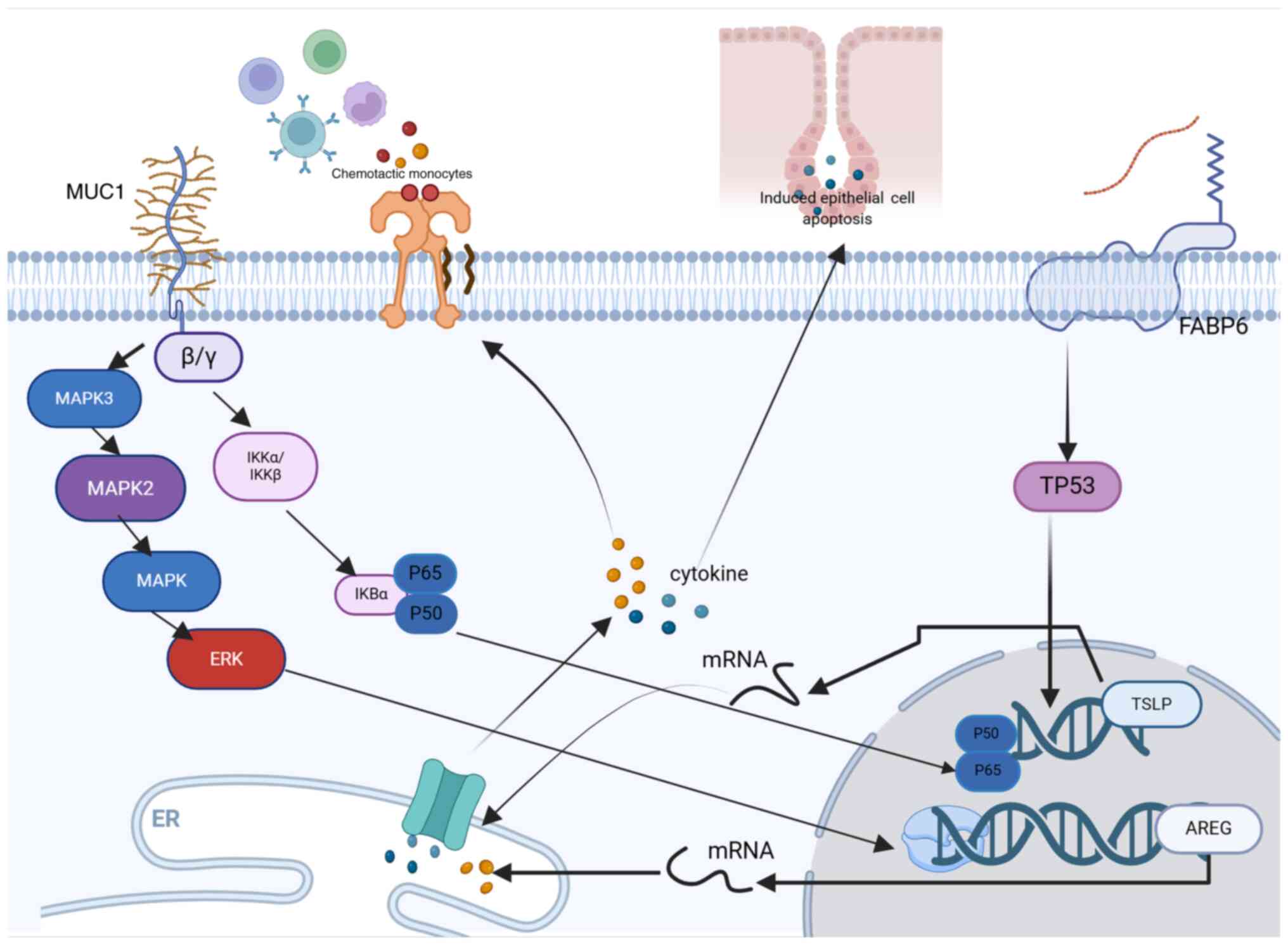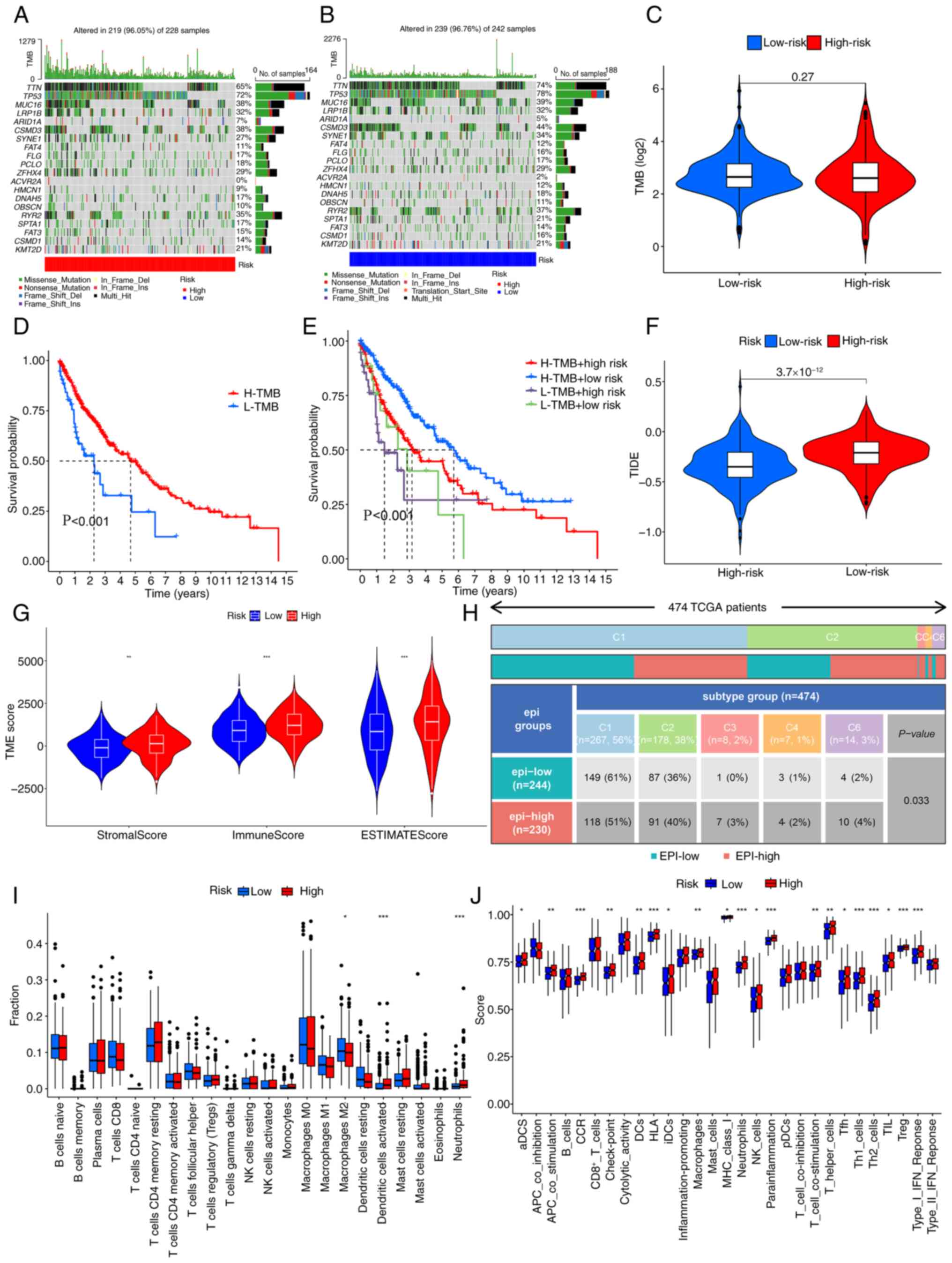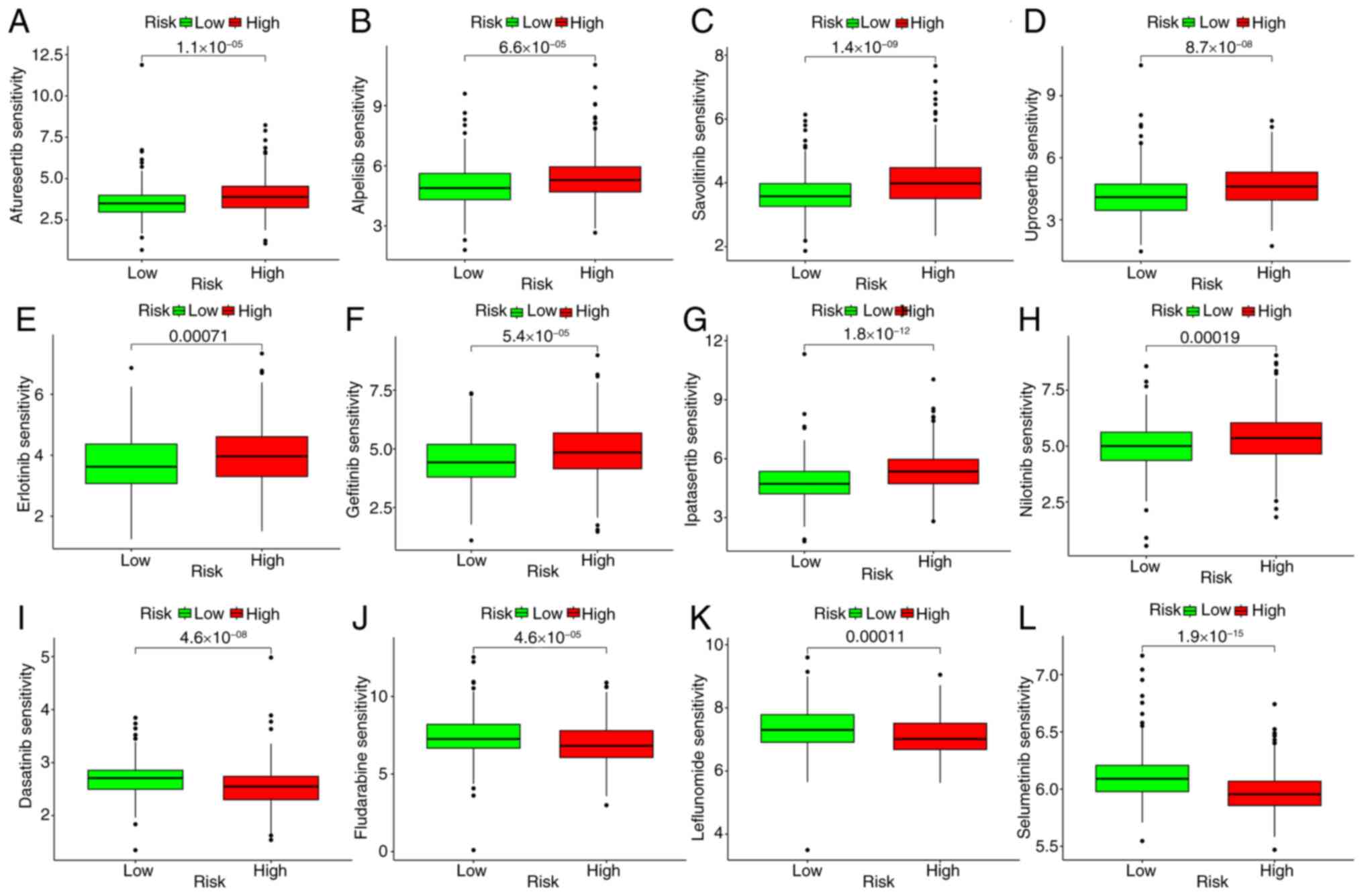Identification and validation of a novel signature based on immune‑related genes from epithelial cells to predict prognosis and treatment response in patients with lung squamous cell cancer by integrated analysis of single‑cell and bulk RNA sequencing
- Authors:
- Published online on: January 23, 2025 https://doi.org/10.3892/ol.2025.14904
- Article Number: 158
-
Copyright: © Wu et al. This is an open access article distributed under the terms of Creative Commons Attribution License.
Abstract
Introduction
Lung cancer ranks has the highest global cancer incidence and mortality rates (1). Lung squamous cell carcinoma (LUSC)has an age-standardized incidence rate of 7.7 per 100,000 in male, accounting for approximately30% of all non-small cell lung cancer (NSCLC) cases and is the second most prevalent subtype of NSCLC (2). The diagnosis and therapeutic intervention for individuals afflicted with pulmonary carcinoma are of paramount significance. The traditional tumor (T)-node (N)-metastasis (M) staging system (3) provides current cancer classification guidelines (4); This classification, based solely on tumor cell characteristics and neglecting the patient's immune profile, paradoxically leads to significant prognostic variability among patients within the same TNM stage, with some in earlier stages faring worse than those in later stages (5). Therefore, a prognostic model that integrates robust biomarkers with the TNM staging system has the potential to forecast patient prognoses with greater precision.
Single-cell analysis of cell heterogeneity in complex systems is a valuable tool. It can be used to define the global gene expression profile of individual cells, thus facilitating the analysis of previously unknown genes in cell populations (6). Joanito et al (7) reported the role of epithelial cells in the evaluation of prognosis of patients with colorectal cancer. Moreover, the contributions of epithelial cells to cancer treatment were reviewed by Chen et al (8) and Huang et al (9) constructed an EIGs prognostic model for predicting long-term prognosis in patients with gastric carcinoma. However, the prognostic value of the ECIG for LUSC remains unclear.
Therefore, the aim of the present study is to explore the biological functions of EIGs in LUSC patients and assess their potential value for prognostic prediction. The present study constructed an EIGs prognostic model based mainly on single-cell (sc) mixed bulk RNA sequencing (RNA-seq) and assessed the prognosis of patients with LUSC using enrichment pathway analysis, tumor mutation burden (TMB) analysis, tumor microenvironment differentiation analysis and drug sensitivity prediction, as well as an evaluation of its scientific value.
Materials and methods
Data sources and disposal
The Gene Expression Omnibus (GEO) database(ncbi.nlm.nih.gov/geo/) contains scRNA-seq data for two purified LUSC samples (GSM3304009 and GSM3304010). The Cancer Genome Atlas (TCGA) (portal.gdc.cancer.gov/) provides bulk RNA-seq data for patients with LUSC, covering 502 tumor cases and 51 normal cases (dataset name: TCGA-LUSC). Following the elimination of cancer patients lacking survival information, a total of 488 cancer patients were incorporated into the study. In addition, the GSE37745, GSE73403 and GSE74777 datasets were sourced from the GEO. These datasets were combined into a single set and adjusted for batch variations using the ‘ComBat’ function in the ‘sva’ package (Version: 3.54.0), with all data transformed to log2 values (10).
Identifying epithelial marker genes using scRNA-seq
The present study used the R packages ‘Seurat’, ‘Singler’ and ‘magrittr’ to analyze scRNA-seq data (11). Raw arrays for each sample were filtered, excluding genes expressed in fewer than three individual cells, cells with fewer than 50 genes, and cells with more than 5% of genes encoded by mitochondria. First, the scRNA-seq dataset was normalized using the ‘NormalizeData’ property in the Seurat R bundle, and the statistics were transformed into standardized scRNA-seq objects. The feature ‘FindVariableFeatures’ was used to detect the first 1,500 highly variable genes. Second, a principal component analysis (PCA) was performed. Previously, a JackStraw evaluation was used to screen for essential PCs), and 20 PC cells were selected for cluster assessment at P<0.05. The FindNeighbors property was used to compute the closeness of clusters, whilst the FindClusters property was used to analyze mobile clusters. The mobile clusters were subsequently validated with RunTSNE, and the FindAllMarkers property was used for each cluster to compute the differentially expressed genes (DEGs), for which logFoldChange=1 and the expression ratio of the least differential genes=0.25. Subsequently, each cell cluster was annotated with the ‘CreateSinglerObject’ property in the ‘Singler’ package. Finally, using the ‘monocle’ package in R, a quasitemporal analysis was performed (12). Based on the temporal gene expression of each cell, each cell was arranged according to a quasitemporal pattern, and this model was split once into multiple cell groups (states) based on gene expression status to create an intuitive lineage improvement tree.
Model construction and validation
Immune-related genes were retrieved from two comprehensive databases(Immport gene list and InnateDB Innate Immunity Genes), Immport (https://www.immport.org/home) and InnateDB (https://www.innatedb.ca/). By evaluating the expression of epithelial marker genes filtered in the preceding step, 278 EIGs were identified. To further assess the clinical relevance of these identified EIGs, univariate Cox regression analysis was performed. Genes exhibiting P<0.05 were deemed prognostic indicators. The protein interaction community was then evaluated using the protein-protein interaction network and the hyper-linkages between the DEGs was consequently determined. To improve the precision of the predictive gene screening, an extensive evaluation using both least absolute shrinkage and selection operator (LASSO) and Cox was performed. This analysis was executed using the ‘glmnet’ software package, which is tailored for fitting generalized linear models via penalized maximum likelihood. The LASSO model was used to evaluate survival according to Cox, and the ‘cv. glmnet’ capability was subsequently used to verify the first-class model (13). LASSO and Cox regression analysis were applied to elucidate genes with significant prognostic value. The differentially expressed EIGs coefficients are presented in Table SI. This technique enabled the systematic analysis of gene expression and risk factors, ultimately leading to the creation of predictive models. Patients were stratified into distinct risk categories using a risk score threshold of 0.91. The basic information of patients in the test group and the training group are presented in Table I. To assess the predictive accuracy of the EIGs, the area under the curve (AUC) was calculated using the ‘survival ROC’ package. A nomogram for 1-, 3- and 5-year outcomes was developed based on age, sex, tumor stage and risk model with the ‘RMS’ package. Decision analysis was performed using the ‘ggDCA’ package. The ‘survminer’ package and Kaplan-Meier methods were used to perform survival analysis. To mitigate the impact of confounding factors on survival curves, the two-stage (TS) test was used to address potential issues of curve crossover in survival analysis (14). Finally, survival analysis using an independent dataset sourced from the GEO (accession nos. GSE37745, GSE73403 and GSE74777; ncbi.nlm.nih.gov/geo) corroborated the predictive capability of the model regarding survival outcomes.
Enrichment analysis
Detailed and in-depth gene set enrichment analysis (GSEA) was performed on the gene sets ‘c5.go.Hs.symbols.gmt’ and ‘c2.cp.kegg.Hs.symbols.gmt’ obtained from the MSigDB database (docs.gsea-msigdb.org/#MSigDB/MSigDB_FAQ) (15). Furthermore, using the ‘Cluster Profiler’ R package, Gene Ontology (GO) enrichment analysis was performed to assess the cellular and molecular characteristics of EIGs, and Kyoto Encyclopedia of Genes and Genomes (KEGG) pathway enrichment analysis was used to evaluate their roles in several metabolic and signaling pathways (16). The GO annotation was based on the Bioconductor Project's complete genome annotation package (org.Hs.eg.db). KEGG elucidated the advanced functions, networks and applications of biological systems, providing a foundation for further research. The ‘cluster profiler’ tool was utilized, which uses the Web API to query the most up-to-date KEGG database, obtain path data and perform functional analysis. The threshold of P<0.05 was applied to determine enrichment. Distinct GO and KEGG plots were generated, illustrating variations in gene numbers and selection criteria.
Tumor immune correlation analysis
Using the ‘biolinks’ software tool, LUSC mutation information from TCGA database was analyzed to assess the disparities in TMB between risk cohorts. A waterfall plot was subsequently generated using the ‘maftools’ tool to display the top 20 genes with notable mutation differences. This visualization enabled the comparison of the distinct variations in mutation burden among different risk cohorts. Subsequently, the expression data were processed using the ESTIMATE algorithm (1.0.13, bioinformatics.mdanderson.org/), leading to the assessment of the stromal score, immune score and overall ESTIMATE score in LUSC (17). CIBERSORT(0.1.0, http://cibersortx.stanford.edu/) was subsequently used to identify 22 invasive immune cells. Subsequently, immune typing analysis was performed using the R package ‘RColorBrewer’ (18). single-sample GSEA (ssGSEA) was then used to measure immune function in different risk groups. Furthermore, TIDE score files were retrieved from the TIDE site (tide.dfci.harvard.edu/) to compare the different scores among different risk groups.
Immune checkpoint and IMvigor210
An analysis of the expression of 79 immune checkpoint genes was performed across different groups to assess tumor immunity, and the ‘ggpubr’ software suite was used to scrutinize disparities in immunosuppressive molecules associated with immune checkpoints (19). Furthermore, gene transcription data from 298 patients with uroepithelial carcinoma was retrieved from the IMvigor210 cohort and their responsiveness to immunotherapy was forecasted to appraise the immunotherapeutic efficacy of the risk model in the present study and to prognosticate the outcome of the IMvigor210 immunotherapy regimen (20).
Drug sensitivity test
The drug susceptibility of LUSC was predicted using the R-editing language ‘parallel’ and the ‘oncoPredict’ package. Moreover, using the ‘ggplot2’ package, the susceptibility of the high-risk group to 198 drugs was plotted, considering P<0.05 (21).
Validation by reverse transcription-quantitative PCR (RT-qPCR)
To assess the proposed model, RT-qPCR analysis was performed. RNA was extracted from human LUSC H2195, H711 and H1522 cells (Binhui Biotechnology) and from normal bronchial epithelium 16HBE cells (Binhui Biotechnology) using TRIzol reagent (Takara Bio, Inc.). RT-qPCR was performed using the Probe One Step RT-qPCR Kit (NM_004048, Beijing Quality Biotechnology Co., Ltd.). For RT-PCR, begin with a 70°C incubation for 10 min, then synthesize cDNA at 37°C for 65 min, hold at 15.8°C for 150 min, and finally maintain at 4°C. For qPCR, use SYBR Green I (Vazyme Medical Co., Ltd.) as a fluorescent marker. Thermocycling conditions were as follows: Initial denaturation at 95°C denaturation for 2–10 min, followed by 40 cycles of 95°C for 10 sec and 60°C for 30 sec. Finally, the 2−ΔΔCq method (22) was used to normalize sample gene expression for the final result calculations. Normalization involved using ΔCT and the efficiency measured for the reference gene to calculate the ETΔCT/ERΔCT ratio (23). To compare the expression levels between LUSC cells and normal cells, the unpaired t-test was used for statistical analysis. The aforementioned method enabled precise measurement and comparison of significant gene expression variations across several cell types. The primers used in the RT-qPCR experiment are listed in Table SII.
Protein expression
To assess the protein expression differences in patients with LUSC and healthy individuals, a thorough analysis was performed using data obtained from the Human Protein Atlas (HPA) database (AREG, MUC1 and FABP6; proteinatlas.org/). This comprehensive dataset was used to assess the protein expression profiles of the chosen EIGs in both LUSC and normal tissues and the analytical method enabled the comprehensive understanding of the expression patterns and variations of these genes across different samples.
Statistical analysis
Statistical analyses were carried out using R version 4.2.1, and the corresponding R packages were also based on this version. A P-value threshold of less than 0.05 was used to determine significance, except where explicitly stated otherwise.
Results
Identification of epithelium-related genes
As illustrated in Fig. 1, which presents the study flowchart, scRNA-seq was performed on a sequence of 2,470 LUSC samples. Furthermore, Fig. 2A demonstrates the range, sequencing depth and % of mitochondria for each sample. After a quality control filtration process was used to remove poor-quality cells, the remaining cells were subjected to subsequent analysis. After sample normalization, 7,950 low-mutation genes were excluded and 1,500 highly variable genes were selected (Fig. 2B). Subsequently, the PCA method was applied to simplify the variables within the dataset (Fig. 2C and D). Moreover, to perform a more detailed and in-depth analysis, 20 PCs) were selected, each exhibiting P<0.05, ensuring their statistical significance. Subsequently, the t-SNE algorithm (2.0, geeksforgeeks.org) was used, which allowed the visual mapping and distinguishing of the 12 clusters present within the sample, thus providing a clearer representation of the data distribution and relationships (Fig. 2E). Using the ‘single-R’ package in R (bioconductor.org/packages/release/bioc/html/SingleR.html), it was demonstrated that Clusters 0, 2, 3, 7 and 10 were classified as epithelial cell subpopulations. The expression patterns of distinct genes in individual cell clusters are shown in Fig. 2F. Finally, the developmental trajectory of epithelial cells was assessed using pseudotime analysis (Fig. 2G).
Model construction and validation
After the overlap of the immune gene set with genes related to the epithelium was confirmed, 278 immune-related genes were identified (Fig. S1A and Table SIII). A single-variable Cox regression analysis was performed using the TCGA LUSC cohort as a training set, and 24 epithelium-related genes (Table SIV) were revealed to be significantly related to overall survival (OS; Fig. S1B). Furthermore, a protein-protein interaction network was constructed using Cytoscape (3.9 http://cn.string-db.org/), and the relationships among the cox genes were demonstrated (Fig. S1C). A total of 8 EIGs were then identified using LASSO analysis, and 4 genes [amphiregulin (AREG), mucin (MUC)1, fatty acid-binding protein 6 (FABP6) and thymic stromal lymphopoietin (TSLP)] were selected for model construction after comparison with Cox regression analysis (Fig. S1D and E). The risk score was calculated as follows: (0.134 × AREG expression) + (0.129 × MUC1 expression) + (0.249 × FABP6 expression) + (−0.199 × TSLP expression). This was followed by an evaluation of the prognostic value of the model. According to the risk score, clinical information of different risk groups was recorded (Table II). Survival rates notably differed between the two risk groups, as indicated by the survival analysis curves, with high-risk patients exhibiting a significantly reduced survival rate, compared with that of the low-risk patients (P=0.007; Fig. 3A). However, the generated curves intersected at the tail end S(t)=0.2. The TS test demonstrated that there was still a significant difference in survival between different risk groups (P=0.00723), indicating that the intersection of the curves did not affect the results. ROC curves were also used to evaluate the prognostic ability of the model. Fig. 3B presents the AUC values at 1, 3 and 5 years, with OS rates for patients with LUAD of 0.698, 0.707 and 0.629, respectively. Similar results were demonstrated for both the experimental group and the entire cohort (Fig. 3C-F), confirming the feasibility of the model. Specifically, for the test cohort, it was revealed that individuals in the high-risk category had a significantly decreased OS rate, and this trend was consistent across all the experimental results. Additionally, through analysis of the expression levels of EIGs, it was revealed that AREG, MUC1 and FABP6 were expressed at higher levels in high-risk patients, indicating increased susceptibility to disease, whilst TSLP was more highly expressed in low-risk patients, suggesting greater resistance (Fig. S2A-C). Moreover, scatter plot analysis indicated that OS was markedly reduced and that the mortality rate was increased (Fig. S2D-I). Kaplan-Meier curves for survival analysis and differential expression of patients with LUSC patients with four model-associated EIGs are shown in Fig. S3. AREG, FABP6, and MUC1 showed decreased expression in the high-risk group compared to the low-risk group, while their expression was elevated in the latter. Conversely, TSLP exhibited lower expression in the low-risk group but was relatively higher in the high-risk group. The survival curves for the AREG and MUC1 genes intersected; therefore, the TS test was performed. The resulting P-values were 0.0314459 and 0.02161114 for AREG and MUC1, respectively. This indicated that despite the intersection, the genes still demonstrated a significant difference in their prognostic implications for survival outcomes.
Clinical OS prediction by the independent prognostic models in patients with LUSC
Univariate and multivariate Cox regression analyses revealed that the risk score held independent prognostic significance in both types of analyses (Fig. S4A and B). Moreover, the clinical circle and heatmap indicated that age and T stage may be independent prognostic factors (Fig. S4C and D). Furthermore, the risk models value was notably greater than that of clinical traits in predicting patient prognosis, according to the nomogram (Fig. 4A). The ROC survival curve also demonstrated that the risk was more predictive than the majority of clinical data (Fig. 4B). Additionally, the decision curve revealed that the risk model had a markedly greater net benefit than the other clinical factors (Fig. 4C). The calibration curve also demonstrated that having a model had a notably greater C-index than having no risk model (Fig. 4D and E). Subsequently, a prospective estimate of patients with LUSC was performed according to age, risk, sex and disease stage (Fig. S5A-C) and survival rates were compared among patients of different ages, sexes, T stages and N stages (Fig. S5D-H) to determine the predictive effect. Notably, there were pronounced differences in risk scores among those aged ≥65 and above, as well as between patients with stage I and stage II tumors. The survival curves plotted by combining clinical features such as age, sex, and tumor stage with the model-predicted risk scores show significant differences between the groups. GEO external data was validated and it was demonstrated that the model is feasible (Fig. S5I).
Enrichment analysis
The GSEA enrichment results indicated that the model gene had a positive association with the ‘granulocytes migration’ and ‘leucocytes migration’, while it showed a negative association with ‘chromosome segregation’ and ‘DNA replication’. Pathway enrichment revealed a high association of the model genes with three pathways related to ‘cytokine-cytokine receptor interaction’, ‘type I diabetes mellitus’ and ‘complement and coagulation cascades’, whilst the association with the ‘DNA replication’ pathway was low (Fig. 5A-D). GO analysis revealed the involvement of immune system genes, T cells, cytokines and white blood cells (Fig. 5E and F). Moreover, KEGG analysis confirmed the close relationship between these genes and the way in which antigen are processed and presented (Fig. 5G and H). According to KEGG analysis, antigen processing and presentation pathways were enriched, and the high-risk group revealed contamination with human T-cell leukemia virus 1. The detailed findings are presented in Table SV. Finally, the potential mechanisms initiated by relevant model genes during the progression of tumors were illustrated (Fig. 6).
Tumor immune correlation analysis of LUSC
The tumor mutation load was assessed in different risk populations. It was demonstrated that the most common mutations in the population were titin and MUC16 (Fig. 7A and B). When comparing TMB across different risk groups, no significant difference was observed (Fig. 7C). Consequently, the outcomes of patients with high and low TMB levels were analyzed. A more favorable prognosis was revealed in patients with a lower TMB than in those with a higher TMB (Fig. 7D). Subsequently, after incorporating the TMB-based risk model, high-risk and low TMB subgroups demonstrated a significantly improved prognosis compared with that of the TMB and low-risk subgroups (Fig. 7E). Although TMB did not show significant differences when comparing different risk groups individually, and even though survival was better in the H-TMB group than in the L-TMB group, after integrating TMB with the high- and low-risk groups defined by our model, survival differences still persisted between different risk and TMB groups (P<0.001). This shows the feasibility of the model in the present study. Subsequently, differences between TIDE and EIGs were assessed. A significant difference in TIDE scores was noted between the two risk groups (Fig. 7F). Due to the significant involvement of epithelial cells in the immune response and migration of tumors, the infiltration of these cells along with immune cells was assessed using data from patients with LUSC. The high-risk cohort exhibited significant variances in matrix scores, immune scores and estimated scores (Fig. 7G). Furthermore, the two risk populations demonstrated markedly different immune types (P=0.033; Fig. 7H). CIBERSORT analysis revealed that in high-risk cases, the proportion of activated dendritic cells, neutrophils and M2 macrophages was markedly higher when contrasted with the levels found in other immune cell populations. (Fig. 7I). Finally, the ssGSEA algorithm revealed a markedly high level of resting dendritic cells and neutrophils in the high-risk population, in comparison with the low-risk population (Fig. 7J).
Immune checkpoint genes and IMvigor210
To further assess the role of epithelial cells as genetic predictors of immunotherapy efficacy, 210 patients in the IMvigor210 cohort were analyzed. Survival analysis revealed significantly lower survival rates after immunotherapy in high-risk patients, compared with low-risk patients (Fig. S6A). Subsequently, the IMvigor210 immunotherapy analysis demonstrated that both high- and low-risk groups exhibited poor sensitivity to immunotherapy (Fig. S6B and C); therefore, immune checkpoints were searched for again. Immune checkpoint genes, which are critical for bypassing autoreactivity, represent new targets for cancer therapy (18). Immune checkpoint proteins poliovirus replication cell adhesion molecule and tumor necrosis factor receptor Superfamily Member 14 (TNFRSF14) exhibit significant differences across various risk groups, and their expression levels correlate with risk scores. (Fig. S6D-G). Significant disparities were observed in the correlations between risk scores and a selection of immune checkpoint proteins, such as cytotoxic T-lymphocyte-associated protein 4, Inducible T Cell Costimulator (ICOS), and CD20, etc. (Fig. S7).
Drug sensitivity test
The present study also evaluated differences in susceptibility between patients at low risk and those at high risk. Reduced susceptibility to anticancer drugs, including gefitinib, savolitinib, ipatasertib, erlotinib, uprosertib, afuresertib, alpelisib and nilotinib (Fig. 8A-H), was demonstrated in patients at low risk of cancer. The pharmaceuticals exhibiting heightened sensitivity within the low-risk cohort are listed in Table SVI. High-risk patients, on the other hand, had lower susceptibility to anticancer agents such as dasatinib, fludarabine, leflunomide, and selumetinib (Fig. 8I-L). Table SVII lists the drugs that show greater sensitivity in the low-risk group. These results indicate that EIGs may be good predictors of the efficacy of anticancer drugs (Table SVIII).
Validation of in vitro model genes
Images of immunohistochemical tissue sections of LUSC and normal tissues obtained from the HPA database demonstrated the differential expression of the selected EIGs genes in both tissue types (Fig. S8A). Analyzed using immunohistochemistry techniques, these sections revealed marked expression differences between cancerous and normal tissues. Furthermore, the present study used RT-qPCR to determine the levels of proteins in LUSC epithelial cells (AREG, FABP6, MUC1 and TSLP). The results revealed a significantly higher expression of AREG and MUC1 in normal tissues compared with that in tumor tissues, whereas there was a significantly higher expression of TSLP and FABP6 in tumor tissues compared with that in normal tissues (Fig. S8B). Overall, the RT-qPCR results were consistent with the aforementioned bioinformatics results.
Discussion
LUSC is a prevalent cancer with a typically poor prognosis (1). Furthermore, traditional TNM staging is not a good predictor of patient prognosis and, in parallel, biomarkers are crucial for identifying biological agents (2). Overall, the present study demonstrated that the prognostic model based on the combination of biomarkers and statistical data was superior to that based on TNM staging. Single-cell analysis, a valuable tool for studying cell heterogeneity in complex systems, is used to analyze previously unknown genes in cell populations (6). The results indicate that the risk scores of four EIGs can act as independent prognostic indicators, with the high-risk group demonstrating worse prognoses. Therefore, the nomogram in the present study has high predictive value. Moreover, the results of immunoinfiltration indicated that the infiltration of activated dendritic cells and neutrophils was greater than that of M0 macrophages. Enrichment analysis also indicated that the presentation of antigens and virus infection may be related to high-risk subgroups. Therefore, the model could be used as a reference for the choice of antitumor agents in patients with LUSC.
The diversity and plasticity of the lung epithelium serve significant roles in the heterogeneity of lung cancer (2). Furthermore, a prognostic model based on the epithelium may be useful for predicting other types of cancer. Joanito et al (7) established a model for evaluating the prognosis of patients with colorectal cancer, whilst Chen et al (8) described the function of epithelial cells in tumor invasion and metastasis. The model in the present study has good forecasting value. Based on the prognostic model, individuals with high-risk EIGs show decreased survival rates. This disparity is attributed to the greater invasive and metastatic capabilities of the high-risk subgroup, leading to a worse prognosis. A total of four prognostic markers EIGs, AREG, MUC1, FABP6 and TSLP were identified. It has been reported that AREG, an epidermal growth factor, contributes to the development of type 2 resistance and tolerability (24). T cells promote fibrotic and immunosuppressive functional states of cancer-associated fibroblasts. AREG monoclonal antibody and IL-33 synergistically inhibit tumor growth (25). MUC1 becomes aberrantly glycosylated in cancers, facilitating the transition to malignancy, promoting tumor progression, and contributing to treatment resistance. MUC1 stabilizes the hypoxia-inducing factor spermidine/spermidine N1-acetyltransferase 1 (SAT1), leading to an increase in SAT1 expression, which induces carbon flux into the tricarboxylic acid cycle (26). As a result, MUC1 is an important mark in developing cancer vaccines (27). Inhibiting FABP6 could offer therapeutic benefits in treating LUSC, making it a promising target for therapy. At present, there are no published FABP6 inhibitors available, and the target is considered susceptible to fragmentation (28). Although TSLP has been extensively studied in the field of type 2 immunity, more recent research has identified an increasing role of TSLP in inflammation and cancer (29). TSLP induces several cytokines, including IL-13, to affect cell proliferation by associating with several macrophages (30). The results of these studies indicate that these genes may be potential targets for experiments to elucidate the underlying molecular mechanisms of LUSC. In addition, a number of studies have reported that AREG has an inhibitory effect in pancreatic cancer and glioma (25,31), TSLP and MUC1 serve an important role in the pathogenesis of breast cancer and pancreatic cancer (26,27), and FABP6 is closely related to digestive system tumors (28). This suggests that other patients with cancer could also benefit from using the model in the present study.
In the present study, the molecular mechanisms involved in disease development process were identified through an enrichment analysis. GSEA identified several antigen-presenting pathways related to enrichment in high-risk subgroups. Epithelial cell surface receptors may mediate tumor immune signaling, which results in antitumor immunity. Furthermore, KEGG analysis revealed an association between the incidence of LUSC and several viral infections, such as human T-cell leukemia virus 1 and Epstein-Barr virus (EBV), and that EBV infection is characteristic of lung lymphoepithelioma cancer. Small cell lung cancer is closely linked to human T-cell leukemia virus 1 infection (32). Therefore, a patient with a high risk score has a poor prognosis, partly due to the presence of tumor antigens and viral infection, which are associated with the proliferation and progression of LUSC. In the present study, different methodologies were applied to compare immune cell abundance among the risk groups. The results indicated that in high-risk tumors, immune cells, especially macrophages and DCs, were infiltrating, pointing to the essential function of immune cells in the development of LUSC.
Furthermore, the expression levels of HAVCR2, HLA-A, CEACAM1, indoleamine 2,3-dioxygenase 1, VTCN1 and TNFRSF14 were revealed to differ substantially between the two risk groups, suggesting their potential involvement in the pathogenesis of tumors. The weak association between immune checkpoint proteins exhibit a low correlation with risk scores might be attributed to limited sample size and patient numbers, potentially impairing the study's statistical power and hindering the identification of substantial correlations between these proteins and risk scores. Furthermore, it's possible that after adjustments for multiple testing, these correlations could cease to be statistically significant. Among them, the expression of HLA and TNF-α were most notable. In the same way that infliximab is used to treat breast cancer and trastuzumab is used to treat severe Crohn's disease (33,34), we hypothesize that the two monoclonal antibodies that act on HLA and TNF are potentially useful in treating LUSC. This may be a potential new discovery in the field of cancer treatment. To provide guidance for treating LUSC, 198 different risk groups were assessed and it was demonstrated that certain agents, such as erlotinib and gefitinib, have been used as first-line treatments. Notably, most of the drugs affect EGFR, which is in line with the present research on the relevant pathways.
The present study has certain merits. Currently, to the best of our knowledge, there are no other studies that have reported the success of the EIGs model in predicting the outcome of LUSC. sc-RNAseq was used to investigate gene expression diversity at the cellular level. This advanced method is complemented by the addition of bulk RNA sequencing, allowing us to blend data from epithelial cell marker genes with immune-related gene sets. The present model combined epithelial cell biology and tumor immunity, which has demonstrated a robust predictive capability. To assess the precision of this risk model, a comparative analysis was performed with studies of a similar nature. Firstly, compared with the T-cell-related prognostic model for LUSC constructed by Shi et al (35), our study delves more deeply into the immune checkpoint responses and explores their potential application in guiding anticancer drug selection for LUSC patients. Second, compared with the fibroblast model used by Lai et al (36), the model in the present study was validated using RT-qPCR. However, the research is based on one of several databases, and additional supporting data are needed. Therefore, additional clinical investigations are essential to validate the findings of these studies.
The present study has certain limitations, including generalizability across different datasets and potential batch processing effects on results. To mitigate these issues, data was used from a single source in one database for both experimental and control groups and randomization was applied. The single-cell datasets were also sourced from the same institution using consistent methods. Rather than combining two datasets for single-cell and large-scale RNA sequencing, gene intersections were focused on. For external validation with GEO datasets, the ComBat function from the R package ‘sva’ was used, which removes batch effects by treating the batch variable as a separate argument. This produces calibrated measurements, allowing for standard analytical techniques or further adjustments to eliminate unwanted variation, thereby enhancing the reliability of the combined datasets.
In conclusion, the model based on EIGs and the nomogram demonstrated high effectiveness in predicting prognosis for patients with LUSC. The high risk group was associated with viral infections and antigen presentation. Furthermore, drug sensitivity analysis revealed that the high-risk group exhibited heightened sensitivity to drugs, such as gefitinib and savolitinib. However, these conclusions need to be substantiated through further experimental and clinical studies.
Supplementary Material
Supporting Data
Supporting Data
Acknowledgements
Not applicable.
Funding
The present study was supported by National Natural Science Foundation of China (grant no. 81560345).
Availability of data and materials
The data generated in the present study may be requested from the corresponding author.
Authors' contributions
JW, ZL, WZ, ZH, KG, JY and WZ conceived the study, wrote the manuscript and revised it. JW, ZL, WZ and JY performed experiments and data analysis. JW, ZL, WZ, ZH, KG, JY and WZ analysis or contributed to interpretation of data. JW, JY and WZ also revised the manuscript. JY and JW confirm the authenticity of all the raw data. All authors have read and approved the final manuscript, agreed to be accountable for all aspects of the work and contributed to data analysis as well as drafting or revising the article.
Ethics approval and consent to participate
Not applicable.
Patient consent for publication
Not applicable.
Competing interests
The authors declare that they have no competing interests.
Glossary
Abbreviations
Abbreviations:
|
EIGs |
epithelial immune-related genes |
|
DEG |
differential expression genes |
|
GSEA |
gene set enrichment analysis |
|
KEGG |
Kyoto Encyclopedia of Genes and Genomes |
|
LUSC |
lung squamous cell carcinoma |
|
NSCLC |
non-small cell lung cancer |
|
OS |
overall survival |
|
PCA |
principal component analysis |
|
ROC |
receiver operating characteristic |
|
TCGA |
The Cancer Genome Atlas |
|
TMB |
tumor mutation burden |
|
TIDE |
tumor immune dysfunction and exclusion |
References
|
Bray F, Laversanne M, Sung H, Ferlay J, Siegel RL, Soerjomataram I and Jemal A: Global cancer statistics 2022: GLOBOCAN estimates of incidence and mortality worldwide for 36 cancers in 185 countries. CA Cancer J Clin. 74:229–263. 2024. View Article : Google Scholar : PubMed/NCBI | |
|
Rodak O, Peris-Díaz MD, Olbromski M, Podhorska-Okołów M and Dzięgiel P: Current landscape of non-small cell lung cancer: Epidemiology, histological classification, targeted therapies, and immunotherapy. Cancers (Basel). 13:47052021. View Article : Google Scholar : PubMed/NCBI | |
|
Piñeros M, Parkin DM, Ward K, Chokunonga E, Ervik M, Farrugia H, Farrugia H, Gospodarowicz M, O'Sullivan B, Soerjomataram I, et al: Essential TNM: A registry tool to reduce gaps in cancer staging information. Lancet Oncol. 20:e103–e111. 2019. View Article : Google Scholar : PubMed/NCBI | |
|
Bruni D, Angell HK and Galon J: The immune contexture and immunoscore in cancer prognosis and therapeutic efficacy. Nat Rev Cancer. 20:662–680. 2020. View Article : Google Scholar : PubMed/NCBI | |
|
Sands JM, Nguyen T, Shivdasani P, Sacher AG, Cheng ML, Alden RS, Jänne PA, Kuo FC, Oxnard GR and Sholl LM: Next-generation sequencing informs diagnosis and identifies unexpected therapeutic targets in lung squamous cell carcinomas. Lung Cancer. 140:35–41. 2020. View Article : Google Scholar : PubMed/NCBI | |
|
Han X, Zhou Z, Fei L, Sun H, Wang R, Chen Y, Chen H, Wang J, Tang H, Ge W, et al: Construction of a human cell landscape at single-cell level. Nature. 581:303–309. 2020. View Article : Google Scholar : PubMed/NCBI | |
|
Joanito I, Wirapati P, Zhao N, Nawaz Z, Yeo G, Lee F, Eng CLP, Macalinao DC, Kahraman M, Srinivasan H, et al: Single-cell and bulk transcriptome sequencing identifies two epithelial tumor cell states and refines the consensus molecular classification of colorectal cancer. Nat Genet. 54:963–975. 2022. View Article : Google Scholar : PubMed/NCBI | |
|
Chen HT, Liu H, Mao MJ, Tan Y and Mo XQ: Crosstalk between autophagy and epithelial-mesenchymal transition and its application in cancer therapy. Mol Cancer. 18:1012019. View Article : Google Scholar : PubMed/NCBI | |
|
Huang Z, Wu C, Liu X, Lu S, You L, Guo F, Stalin A, Zhang J, Zhang F, Wu Z, et al: Single-cell and bulk RNA sequencing reveal malignant epithelial cell heterogeneity and prognosis signatures in gastric carcinoma. Cells. 11:25502022. View Article : Google Scholar : PubMed/NCBI | |
|
Yu K, Lin CJ, Hatcher A, Lozzi B, Kong K, Huang-Hobbs E, Cheng YT, Beechar VB, Zhu W, Zhang Y, et al: PIK3CA variants selectively initiate brain hyperactivity during gliomagenesis. Nature. 578:166–171. 2020. View Article : Google Scholar : PubMed/NCBI | |
|
Aran D, Looney AP, Liu L, Wu E, Fong V, Hsu A, Chak S, Naikawadi RP, Wolters PJ, Abate AR, et al: Reference-based analysis of lung single-cell sequencing reveals a transitional profibrotic macrophage. Nat Immunol. 20:163–172. 2019. View Article : Google Scholar : PubMed/NCBI | |
|
Cao J, Spielmann M, Qiu X, Huang X, Ibrahim DM, Hill AJ, Zhang F, Mundlos S, Christiansen L, Steemers FJ, et al: The single-cell transcriptional landscape of mammalian organogenesis. Nature. 566:496–502. 2019. View Article : Google Scholar : PubMed/NCBI | |
|
Wang Q, Qiao W, Zhang H, Liu B, Li J, Zang C, Mei T, Zheng J and Zhang Y: Nomogram established on account of Lasso-Cox regression for predicting recurrence in patients with early-stage hepatocellular carcinoma. Front Immunol. 13:10196382022. View Article : Google Scholar : PubMed/NCBI | |
|
Li H, Han D, Hou Y, Chen H and Chen Z: Statistical inference methods for two crossing survival curves: A comparison of methods. PLoS One. 10:e01167742015. View Article : Google Scholar : PubMed/NCBI | |
|
Huang J, Zhang JL, Ang L, Li MC, Zhao M, Wang Y and Wu Q: Proposing a novel molecular subtyping scheme for predicting distant recurrence-free survival in breast cancer post-neoadjuvant chemotherapy with close correlation to metabolism and senescence. Front Endocrinol (Lausanne). 14:12655202023. View Article : Google Scholar : PubMed/NCBI | |
|
Petegrosso R, Li Z and Kuang R: Machine learning and statistical methods for clustering single-cell RNA-sequencing data. Brief Bioinform. 21:1209–1223. 2020. View Article : Google Scholar : PubMed/NCBI | |
|
Smith-Miles K and Geng X: Revisiting facial age estimation with new insights from instance space analysis. IEEE Trans Pattern Anal Mach Intell. 44:2689–2697. 2022. View Article : Google Scholar : PubMed/NCBI | |
|
Singh S, Singh VK and Rai G: Identification of differentially expressed hematopoiesis-associated genes in term low birth weight newborns by systems genomics approach. Curr Genomics. 20:469–482. 2022. View Article : Google Scholar : PubMed/NCBI | |
|
Postow MA, Sidlow R and Hellmann MD: Immune-related adverse events associated with immune checkpoint blockade. N Engl J Med. 378:158–168. 2018. View Article : Google Scholar : PubMed/NCBI | |
|
Xie T, Peng S, Liu S, Zheng M, Diao W, Ding M, Fu Y, Guo H, Zhao W and Zhuang J: Multi-cohort validation of ascore: An anoikis-based prognostic signature for predicting disease progression and immunotherapy response in bladder cancer. Mol Cancer. 23:302024. View Article : Google Scholar : PubMed/NCBI | |
|
Maeser D, Gruener RF and Huang RS: oncoPredict: An R package for predicting in vivo or cancer patient drug response and biomarkers from cell line screening data. Brief Bioinform. 22:bbab2602021. View Article : Google Scholar : PubMed/NCBI | |
|
Livak KJ and Schmittgen TD: Analysis of relative gene expression data using real-time quantitative PCR and the 2(−Delta Delta C(T)) method. Methods. 25:402–428. 2001. View Article : Google Scholar : PubMed/NCBI | |
|
Guénin S, Mauriat M, Pelloux J, Van Wuytswinkel O, Bellini C and Gutierrez L: Normalization of qRT-PCR data: The necessity of adopting a systematic, experimental conditions-specific, validation of references. J Exp Bot. 60:487–493. 2009. View Article : Google Scholar : PubMed/NCBI | |
|
Zaiss DMW, Gause WC, Osborne LC and Artis D: Emerging functions of amphiregulin in orchestrating immunity, inflammation, and tissue repair. Immunity. 42:216–226. 2015. View Article : Google Scholar : PubMed/NCBI | |
|
Sun R, Zhao H, Gao DS, Ni A, Li H, Chen L, Lu X, Chen K and Lu B: Amphiregulin couples IL1RL1+ regulatory T cells and cancer-associated fibroblasts to impede antitumor immunity. Sci Adv. 9:eadd73992023. View Article : Google Scholar : PubMed/NCBI | |
|
Jiang S, Deng T, Cheng H, Liu W, Shi D, Yuan J, He Z, Wang W, Chen B, Ma L, et al: Macrophage-organoid co-culture model for identifying treatment strategies against macrophage-related gemcitabine resistance. J Exp Clin Cancer Res. 42:1992023. View Article : Google Scholar : PubMed/NCBI | |
|
Murthy D, Attri KS, Suresh V, Rajacharya GH, Valenzuela CA, Thakur R, Zhao J, Shukla SK, Chaika NV, LaBreck D, et al: The MUC1-HIF-1α signaling axis regulates pancreatic cancer pathogenesis through polyamine metabolism remodeling. Proc Natl Acad Sci USA. 121:e23155091212024. View Article : Google Scholar : PubMed/NCBI | |
|
Li XX, Wang LJ, Hou J, Liu HY, Wang R, Wang C and Xie WH: Identification of long noncoding RNAs as predictors of survival in triple-negative breast cancer based on network analysis. Biomed Res Int. 2020:89703402020. View Article : Google Scholar : PubMed/NCBI | |
|
Gao T, Cen Q and Lei H: A review on development of MUC1-based cancer vaccine. Biomed Pharmacother. 132:1108882020. View Article : Google Scholar : PubMed/NCBI | |
|
Hendrick AG, Müller I, Willems H, Leonard PM, Irving S, Davenport R, Ito T, Reeves J, Wright S, Allen V, et al: Identification and investigation of novel binding fragments in the fatty acid binding protein 6. J Med Chem. 59:8094–8102. 2020. View Article : Google Scholar | |
|
Braile M, Fiorelli A, Sorriento D, Di Crescenzo RM, Galdiero MR, Marone G, Santini M, Varricchi G and Loffredo S: Human lung-resident macrophages express and are targets of thymic stromal lymphopoietin in the tumor microenvironment. Cells. 10:20122021. View Article : Google Scholar : PubMed/NCBI | |
|
Corren J and Ziegler SF: TSLP: From allergy to cancer. Nat Immunol. 20:1603–1609. 2019. View Article : Google Scholar : PubMed/NCBI | |
|
Matsuzaki H, Asou N, Kawaguchi Y, Hata H, Yoshinaga T, Kinuwaki E, Ishii T, Yamaguchi K and Takatsuki K: Human T-cell leukemia virus type 1 associated with small cell lung cancer. Cancer. 66:1763–1768. 1990. View Article : Google Scholar : PubMed/NCBI | |
|
Mamtani R, Clark AS, Scott FI, Brensinger CM, Boursi B, Chen L, Xie F, Yun H, Osterman MT, Curtis JR and Lewis JD: Association between breast cancer recurrence and immunosuppression in rheumatoid arthritis and inflammatory bowel disease: A cohort study. Arthritis Rheumatol. 68:2403–2411. 2016. View Article : Google Scholar : PubMed/NCBI | |
|
Shi X, Dong A, Jia X, Zheng G, Wang N, Wang Y, Yang C, Lu J and Yang Y: Integrated analysis of single-cell and bulk RNA-sequencing identifies a signature based on T-cell marker genes to predict prognosis and therapeutic response in lung squamous cell carcinoma. Front Immunol. 13:9929902022. View Article : Google Scholar : PubMed/NCBI | |
|
Lai X, Fu G, Du H, Xie Z, Lin S, Li Q and Lin K: Identification of a cancer-associated fibroblast classifier for predicting prognosis and therapeutic response in lung squamous cell carcinoma. Medicine (Baltimore). 102:e350052023. View Article : Google Scholar : PubMed/NCBI |



